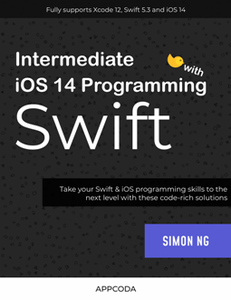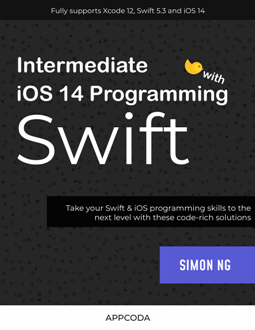Intermediate iOS 14 Programming with Swift
by Simon Ng
English | 2021 | ISBN: n/a | 981 Pages | PDF/ePUB | 267 MB
by Simon Ng
English | 2021 | ISBN: n/a | 981 Pages | PDF/ePUB | 267 MB
At the time of this writing, the Swift programming language has been around for more than four years. The new programming language has gained a lot of traction and continues to evolve, and is clearly the future programming language of iOS. If you are planning to learn a programming language this year, Swift should be on the top of your list.
I love to read cookbooks. Most of them are visually appealing, with pretty and delicious photos involved. On top of that, they provide clear and easy-to-follow instructions to prepare a dish. That’s what gets me hooked and makes me want to try out the recipes. When I started off writing this book, the very first question that popped into my mind was “Why are most programming books poorly designed?” iOS and its apps are all beautifully crafted – so why do the majority of technical books just look like ordinary textbooks?
I believe that a visually stunning book will make learning programming much more effective and easy. With that in mind, I set out to make one that looks really great and is enjoyable to read. But that isn’t to say that I only focus on the visual elements. The tips and solutions covered in this book will help you learn more about iOS 14 programming and empower you to build fully functional apps more quickly.
The book uses a problem-solution approach to discuss the APIs and frameworks of iOS SDK, and each chapter walks you through a feature (or two) with in-depth code samples. You will learn how to build a universal app with adaptive UI, train a machine learning model, interact with virtual objects with ARKit, use Touch ID to authenticate your users, create a widget in notification center and implement view controller animations, just to name a few.
I recommend you to start reading from chapter 1 of the book – but you don’t have to follow my suggestion. Each chapter stands on its own, so you can also treat this book as a reference. Simply pick the chapter that interests you and dives into it.
This book is intended for developers with some experience in the Swift programming language and with an interest in developing iOS apps. It is not a book for beginners. If you have some experience in Swift, you will definitely benefit from this book.
If you want to support my blog, then you can buy a premium account through any of my files (i.e. on the download page of my book). In this case, I get a percent of sale and can continue to delight you with new books!



